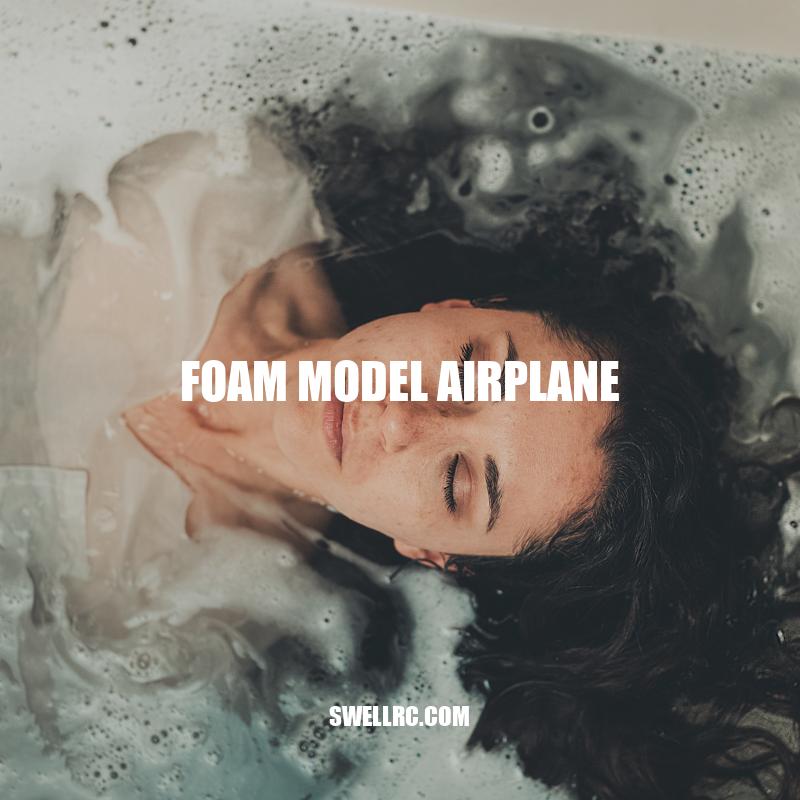Building Foam Model Airplanes: Tips and Techniques
Foam model airplanes have become increasingly popular among enthusiasts over the past few years due in part to their versatility and ease of use. Foam materials such as styrofoam, Depron, and foamboard are popular choices for building model airplanes because they are lightweight, durable, and readily available. When used correctly, foam model airplanes can be made in a variety of shapes and sizes, making them an excellent platform for creativity and experimentation. In this article, we will explore the different types of foam materials available, how to build a foam model airplane, tips for making a successful model, safety precautions to take, and finishing techniques to consider once a model is complete. So, whether you’re a seasoned model airplane builder or just starting, this guide will provide you with the information you need to build your own foam model airplane.
Types of Foam Materials
Foam model airplanes can be made of various materials, and each one has its own unique features. Here are the most common types of foam materials used in building model airplanes:
- Styrofoam – This type of foam material is one of the most popular due to its affordability, ease of handling, and durability. It is also very flexible and can be cut into various shapes and sizes.
- Depron – Depron is a high-density foam that is lightweight and suitable for larger model airplanes. It is more durable than styrofoam and requires special tools for cutting and shaping.
- Foamboard – Foamboard is made of a core of polystyrene foam surrounded by thin sheets of paper or plastic. This material is ideal for creating scale models and can be easily cut and shaped with standard tools.
When it comes to choosing the foam material for your model airplane, consider factors such as availability, durability, and ease of handling. You can find foam materials for your model airplane at local hobby shops, local craft stores, and online retailers such as Amazon and eBay.
What is the best material to make a model plane?
For making a model plane, you can choose from plastic, balsa wood or foam. Among the three, foam is the most affordable and safest option. Building RC airplanes is simplified with foam as it requires purchasing only one 1/2” foam core board for the entire plane (for a 12-18 inch plane). Source: https://en.wikipedia.org/wiki/Radio-controlled_aircraft (as of Nov 24, 2022).
Building a Foam Model Airplane
Building a foam model airplane is easy and can be done by anyone with basic DIY skills. Here are some basic steps on how to build a foam model airplane:
- Design the model airplane – Draw a plan on paper or use software such as CAD to design the model airplane. This step is essential since it will help you to cut and assemble the foam material correctly.
- Cut the foam material – Use a sharp blade or cutter to cut the foam material according to the model airplane design. Use a ruler or a straight edge to ensure precise cuts.
- Assemble the pieces – Join the foam parts together using glue or double-sided tape. Be sure to follow the manufacturer’s instructions for the adhesive you are using.
- Add details – Once the main structure is complete, it’s time to add details such as wheels, propellers, and decals. Use paints and markers to add colors and designs.
- Test the airplane – After finishing the model airplane, it’s essential to test if it flies correctly. Adjust the wing position or use different weights until the airplane is balanced and steady.
It’s crucial to have the right tools and equipment when building a foam model airplane. Here is a table of essential tools:
| Tools | Functions |
|---|---|
| X-Acto Knife | Cutting and shaping the foam material |
| Ruler or Straight Edge | Measuring and drawing precise lines |
| Sandpaper | Smoothing the foam material edges |
| Paint Brushes and Markers | Adding colors and details to the airplane |
| Glue or Double-Sided Tape | Joining the foam parts together |
You can find most of the tools and equipment at a local hardware store or online retailer such as Amazon or eBay.
What foam is best for model airplane?
Depron is a popular foam for smaller RC models that require curved shapes. EPP foam is a flexible variant, and it is used for indoor RC aircraft that are ready to fly. For slightly heavier electric powered RC aircraft, solid foam like foam board or Blucor Fanfold foam is used. If you need more information, you can visit https://en.wikipedia.org/wiki/Radio-controlled_aircraft to learn more about RC models.
Finishing Techniques
Finishing a foam model airplane involves painting and adding finer details such as decals. Here are some useful tips and techniques to create an attractive and polished model airplane:
- Choose the right type of paint – There are many types of paints available, including enamel, acrylic, and spray paints. Choose a paint that is compatible with the foam material you’ve used in constructing the airplane.
- Surface preparation – Before painting, ensure that the surface is clean and smooth. Remove any dirt, dust or oil using a degreaser or rubbing alcohol.
- Use light coats – Apply paint in thin and light coats. Allow each layer to dry before applying the next layer. Avoid applying too much paint in one area as this may cause the foam material to warp or melt.
- Add decals or markings – Decals are an easy way to add details to the airplane. You can purchase decals from hobby stores or online. Alternatively, you can create your decals using a computer and a printer.
- Protect the finished surface – After painting and adding details, protect the surface using a clear coat or varnish. This will help to preserve and protect the paintwork for a longer lifespan.
There are also online resources that provide tips and tutorials on how to finish and paint a foam model airplane. For example, the website FoamFlyer provides a step-by-step guide on how to paint a foam model airplane using acrylic paints. Another useful resource is YouTube, where you can find videos that showcase various finishing techniques.
Can you paint foam airplanes?
Yes, you can paint foam airplanes but bare foam and foamboard are best painted with water-based acrylic paint. Solvent-based paints may dissolve the foam. You can find acrylic paint at Michaels, Wal-Mart and other stores. You can also check out Foamflyer’s RC Airplanes website for more tips on painting foamies.
Tips for Making a Successful Foam Model Airplane
Building a foam model airplane can be challenging, but with the right techniques and approach, you can create a successful model airplane. Here are some tips to keep in mind:
- Read and follow instructions – Before starting, carefully read the instructions that came with the kit or plans. This will help you understand the entire process and avoid mistakes.
- Choose the right foam material – Different types of foam materials have different properties. Choose a foam material that is suitable for the kind of airplane you want to build.
- Use appropriate tools – Having the right tools and equipment is essential for building a foam model airplane. Standard tools include a cutting mat, X-ACTO knife, sandpaper, and a ruler.
- Practice cutting techniques – Cutting the foam material accurately is crucial in building a model airplane. Practice cutting techniques on small pieces of foam before cutting larger pieces.
- Attention to detail – Pay attention to small details and proper scale of the airplane. Accuracy in scale and proportions makes the finished aircraft look more polished.
- Allow time to dry – Patience is a virtue when building foam model airplanes. Allow each layer of glue or paint to dry completely, before moving to the next step.
There are also numerous online forums where you can ask questions, seek advice, and find inspiration from other hobbyists. One such community is RC Groups, which is focused on all types of model aviation. Another online resource is Flite Test, which offers plans, tutorials, and other helpful content for model aircraft enthusiasts.
How do you reinforce a foam plane?
To reinforce a foam plane wing, you can use carbon fiber rods and wood sticks placed inside the foam wing or laminate the foam wing with fiberglass fabric. These methods will help the wing withstand the load during flight. Visit websites such as FliteTest.com or HobbyKing.com for more information and products related to foam plane reinforcement.
Safety Tips While Making Foam Model Airplanes
Although making foam model airplanes can be a fun and rewarding hobby, it’s essential to take safety precautions to avoid accidents. Here are some safety tips to keep in mind:
- Use a cutting mat – A cutting mat can help prevent damage to tables or other surfaces while using a sharp knife.
- Wear protective gear – Wear protective gear like goggles and gloves to safeguard your eyes and hands, respectively.
- Use sharp tools – Dull tools can cause accidents. Always use sharp cutting tools like X-ACTO knife.
- Keep your work area clean and neat – Clean up your work area regularly to avoid slips, trips, and falls.
- Avoid distractions – When working on your foam model airplane, avoid distractions such as mobile phones, television, and anything that can cause you to lose focus.
- Seek professional help when needed – If you’re not experienced with cutting and building foam model airplanes, seek the help of a professional.
It’s always essential to be mindful of safety when working on an intricate project like building foam model airplanes. If you’re unsure of what materials to use or how to get started, several websites offer comprehensive information, such as the Flite Test and RC Groups mentioned earlier. In addition, various kits and products are available online to help make your foam model airplane building safer, easier, and more enjoyable.
How do you protect a foam RC plane?
To protect a foam RC plane, you can apply a clear coat of polyurethane. This will help to prevent damage from scratches, scuffs and minor impacts. Additionally, you can reinforce the vulnerable areas like the wingtips, tail, and nose with fiberglass. There are also tapes and films available that can be applied to the plane for added protection. If you need more guidance, you can watch videos on Youtube such as this one: https://www.youtube.com/watch?v=N60VsMux7Jg.
Conclusion
Building foam model airplanes can be a fun and rewarding experience for hobbyists of all ages. Foam materials are easy to work with, affordable, and can be crafted into beautiful models that can fly remarkable distances. Building a foam model airplane is a creative venture that tests an individual’s skills and patience while allowing them to explore their imaginations.
Getting started on building foam model airplanes may seem overwhelming, but with the right tools, materials, and instructions, anyone can create stunning airplanes that will soar through the skies. With the tips and information provided in this article, beginners can develop the skills needed to create their own foam model airplanes and advanced hobbyists can take their skills to new heights. Remember always to prioritize safety and be mindful of the challenges and rewards of the hobby. Building foam model airplanes can provide endless hours of fun, creativity, and joy for individuals who embrace the hobby.



